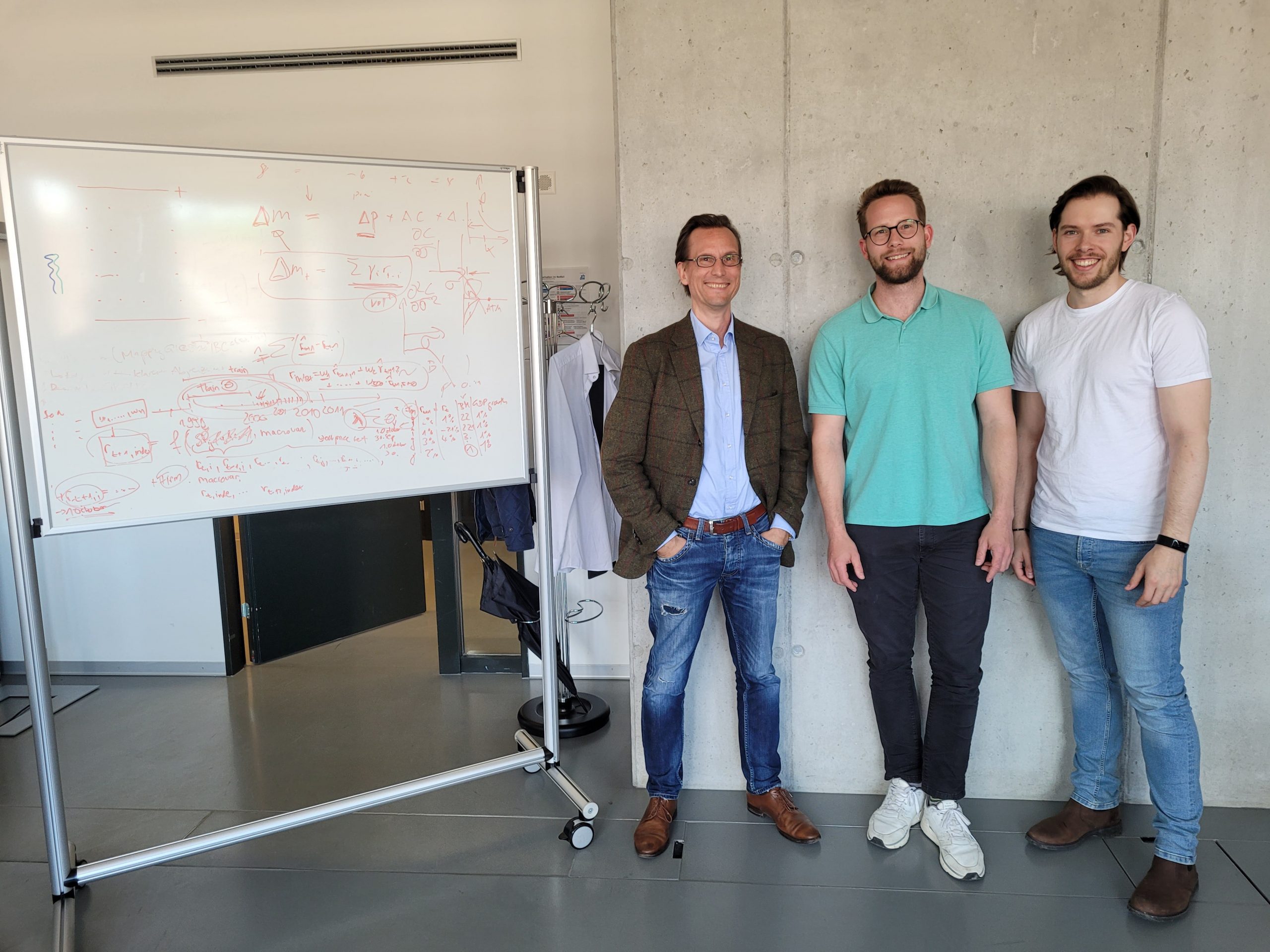The distinction between Finance and Sustainable Finance is what motivates Alexander Posth, Linus Grob and David Jaggi from the Institute of Wealth and Asset Management at the ZHAW School of Management and Law. The institute recently acquired a new supercomputer with which they can process huge volumes of alternative data and thereby detect companies engaged in “greenwashing”.
What is the difference between Finance and Sustainable Finance?
Alexander Posth: Conventional or classical finance is all about risk and return. And we can assess these parameters by looking at conventional financial data, like a company’s balance sheet or the stock price. But in sustainable finance we need to channel investments into the right direction to enable the transition towards a more sustainable economy. If we look at how this can be facilitated, if we look at the challenges we are facing in the upcoming years, we need to consider alternative data.
What do you mean by alternative data?
Alexander Posth: To assess the sustainability profile of a company, it is not enough to look at the balance sheet. That’s why alternative data is concerned with the so-called ESG criteria, that is the environmental, social, and corporate governance impacts (see also info box below). We need to understand where and how the company is operating but also their business model and value chain.
The data necessary to understand this is not embedded in the classical context of finance, but comes from completely different sources, like news feeds, satellite image data or patent data. Some environmental impacts, such as deforestation or air pollution, can be measured with satellite images to see what is going on at or around the production facilities of a company. And only by this we can get an objective assessment of that activity on the immediate environment.
What is the role of a company’s innovations and their new products on the market?
Linus Grob: We also analyse patent data because they provide information on a company’s new technologies. Most countries or regions have their own patent offices, but patent data are very unstructured data sets. Conventional finance data usually comes from finance data vendors in a nice format that is well understood and well prepared. But most of the alternative data we are looking at, such as patent data, needs to be interpreted and put into a financial context and in the context of the ESG criteria, which is what we are doing in our projects.
Can you give an example of such a project?
Linus Grob: We recently finished a research project with EconSight and the University of Basel, where we created a Proof of Concept about the classification of a patent to the innovation field, and an improved scoring of the patent value. We at the ZHAW first classified the patents to see to which technology field the patent contributes to. Then the University of Basel forecast the value score of the patents based on the metadata, the textual data and the numerical features of the patent data.
David Jaggi: A patent is a written document with a claim and a description of the innovation. To analyse this data, we use Natural Language Processing models. Each patent belongs to a certain technology field, such as electric vehicles, battery technology or waste management for example. To determine the right category with Natural Language Processing models, we analyse the text within the patterns from our samples and found certain words that correlate with each technology field. For example, if we look at electric vehicles, the text may contain words such as vehicle, battery, loading or charging. And if another patent contains the same words, it is likely that it also falls within this category.
Defaulttext aus wp-youtube-lyte.php
Why is this important in the context of sustainability?
Alexander Posth: Based on patent data, we can identify whether certain companies are active in green technologies and whether they’re advancing certain aspects of science or innovation in the context of sustainability. This also means that we can identify “greenwashing”, that is seeing if companies are “green” not only in what they’re saying, but also in what they’re doing.
David Jaggi: The problem within sustainable finance is that it’s a new field with a rapid development. Currently there is a lack of standardisation for the different ESG scores by different rating providers. For example, Nestlé can be very well rated by one provider but average by another.
How can investors know if a company is really sustainable or just “greenwashing”?
David Jaggi: In one project we’re planning to detect “greenwashing” by analysing the companies’ corporate communications. Whenever a company talks about sustainability, we will notice this using Natural Language Processing and derive a certain score based on what they communicate. We can then compare this communication with their patent portfolio.
We will publish our results in scientific articles, in which we highlight the data sources and the methods we use. These can be used by other researchers or professionals in finance, such as asset managers who want to assemble a “green” portfolio for some of their clients.
What technology is needed to do this complex analysis?
David Jaggi: We recently acquired a new hardware at the institute to manage this data. The alternative data sets that we work with are very large. The patent data sets, for example, contain over two and a half million patents with a lot of text, that is about 200 gigabytes of data. Data sets of satellite images could be even larger.
This hardware, the DGX station by Nvidia, has a lot of storage and four dedicated GPUs. And with this hardware we can train deep learning models, for example to detect something on a satellite image.
What are the benefits of this kind of supercomputer?
David Jaggi: The sheer amount of data which we need to process to extract the information we want, cannot be analysed with a conventional laptop or desktop. To understand the ESG implications in finance, we need to have a more powerful hardware infrastructure. We have over 250 gigabytes of RAM within the station, and since we also have access to those four dedicated GPUs, we are able to train the models much faster than before.
Alexander Posth: Keep in mind that in sustainable finance we use alternative data in addition to conventional data, such as balance sheet data and stock prices, because we want to infer new information from the data. In the end, we can come up with an assessment which, for example, would enable a pension fund to structure their investment portfolio towards more sustainability. These recommendations need a link between whatever we can infer from satellite data or patent data as well as the company’s financial context.
What’s next in sustainable finance?
Linus Grob: I’d like to believe that we are working on the frontier of sustainable finance.
Alexander Post: I agree, and I can’t think of any other research groups that currently looks at the data in the specific way we are.
David Jaggi: Since we now have the capability to process data which we couldn’t process before, we can make sense of data with a certain focus, such as sustainability in this case. For example, previously, we were analysing data from news feeds with respect to risk and return or to forecast the stock price. Now we analyse the same data set but with a completely different focus and I assume there will many more alternative datasets with which we could shed some light on other angles besides sustainability. The weirder the data set, the more interesting I assume the outcome could potentially be.
Alexander Posth: Right, and it’s not only about data. The interesting challenge lies in the questions which are asked in the context of sustainability. CO2 emissions, for example, are straightforward to measure and this has been done for quite some time. But now we can take other factors into account as well, such as deforestation, water quality and even loss of biodiversity.
What’s the main challenge in the future?
Alexander Posth: If you look, let’s say, at a car producer, you can measure its CO2 emissions and you can price this. But if you look at a mining company and find out that around one of their mines a certain species is disappearing, there are many questions that need to be answered: how can we detect in an objective way that the species is gone? Can I attribute that to the activities of the mining company? And then finally, what is the impact on the mining company’s balance sheet? To make this link you not only have to come up with very innovative ways of sourcing and analysing data, but you also have to come up with very good models to link cause and effect. This is the main challenge we face in the future – and which we are addressing in our research projects together with our partners from academia and the financial industry.
Defaulttext aus wp-youtube-lyte.php
What are ESG criteria?
ESG stands for environmental, social, and corporate governance. Every company has an ESG score, for example provided by MSCI, Bloomberg and Thomson Reuters, which measures how sustainable a company is or how sustainable a company operates. Environmental impacts are for example, the impact on climate change, carbon emission, air and water pollution. The social impacts measure, for example, customer satisfaction, data protection and privacy. And the corporate governance impacts consider the company’s board composition or the audit committee structure. The ESG score is derived from those different attributes and the overall sustainability score.

